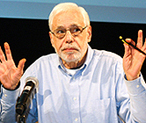| Online Migration of Newspapers | ||||
|
The fate of newspapers is an ongoing subject for the Forum. This conversation explores the migration of newspapers to the internet and what that means for traditional concepts of journalism. Amid the emergence of citizens' media and the blogosphere, newspapers are adapting to a changing mediascape in which print readership is in steady decline. David Carr, culture reporter and media columnist for the New York Times, and Dan Kennedy, professor of journalism at Northeastern University and author of the Media Nation blog, explore these developments with Forum Director David Thorburn. Among their topics: the best and the worst examples of news on the net, online-only news sites, hyperlocal news and collaborative journalism, business models for online newspapers, and the impact of social media on journalism. A podcast of Online Migration of Newspapers is avalable. Video of Online Migration of Newspapers is available. [This is an edited summary, not a verbatim transcript.] By M. Flourish Klink
"Do you remember the fax machine?" David Carr began the Forum by recalling his wonder at first encountering a fax machine. "It sounds Flintstones now, but at the time, it sounded so Jetsons." New media, he argued, has strengthened journalism far more than it has harmed it. In fact, there's "much more fact-based reporting in my stuff now than there used to be, because it's there, online for the having." According to Carr, the distinction between old and new media is breaking down. "Hybrid" media, as he calls it, is everywhere. Text, video, and audio are converging, so that organizations deliver news in any format. The audience has begun to take part in news reporting, but they're not doing it in cordoned-off blogs; rather, the mainstream media and new media outlets are "marching toward each other." As a result, some online news sites are turning into collectives of established reporters. For example, print journalists Peter Goodman of the New York Times and Howard Fineman of Newsweek recently jumped ship to the Huffington Post; while prize-winning media columnist Howard Kurtz of the Washington Post has joined Tina Brown’s online The Daily Beast. Journalists have begun to build personal brands in their reporting specialty, and often to reach much wider audiences when they blog on an established news site. But Carr warned against undervaluing the continuing power of the print newspaper. He said his immense following (in the hundreds of thousands) on Twitter was surely due to his work as a Times columnist and cultural reporter. More significantly, when an article of his is placed prominently on the front page of the Times, above the fold, he can track its viral life on the Internet where its visibility and duration are exponentially greater than if his piece had been posted as a bog entry or buried much deeper in the paper Times itself. In the future, Carr predicted, "No matter what channel: there won't be new or old media, just media."
Dan Kennedy summarized the trap that newspapers have fallen into. "Fifteen years ago, we started down this road of moving newspapers to the web. At first, it didn't seem illogical to suppose that once we'd gotten rid of printing and distribution costs, the advertising that would flow in would result in a bright and happy new era for everybody. But a few years after the transition began, the advertising business fell down." Craigslist killed the classifieds; the prevalence of malls destroyed display advertising. Kennedy suggested that we focus on a new economic model for journalism: non-profit newspapers. The New Haven Independent, for example, focuses on the needs of New Haven's city center, not the more affluent suburbs that are covered by for-profit papers. The primary technology the New Haven Independent uses is bicycles; their reporters ride around with notebooks, smart phones, and point-and-shoot cameras, covering the city in the most traditional, old-fashioned sort of way. They get statehouse news from a one-woman operation, a website called CT News Junkie. Their budget is around $500,000, currently 75% funding and the rest from contributions, but they're looking to reverse these percentages, for a more stable and supportable model. All in all, non-profit newspapers are currently more lucrative than for-profit newspapers, and they may be part of the future of journalism. David Thorburn responded to both speakers by saying that only a year ago he would have expected them to offer a much more melancholy assessment of the state of newspapers. Is there no dark side, he asked, to the "benign sort of convergence" that Carr described?
Both Carr and Kennedy agreed that the fate of regional newspapers is particularly dire. The Boston Heralds of the world are endangered. They do excellent reporting on sports and regional issues, but are too big to do local news well and too small to cover national and international stories properly. Even their sports coverage is being eaten away by ESPN. Thorburn asked Carr to discuss the cult of the individual reporter. Carr cited Brian Stelter of the Times as an example of a young journalist who is as adept in print as in digital formsand has built a personal brand at the Times. While the Times has done a good job so far of negotiating between their larger brand and their reporters' smaller brands, Carr said, it would be interesting to see if Stelter continues to submit to the Times’ "velvet handcuffs,” or whether eventually he begins to feel entrepreneurial and strike out on his own. Personal brands can be a wonderful thing, however; Carr pointed out that his own brand opened doors for him, allowing interviewees to feel at ease with him (though they'd never met). In response, Kennedy emphasized how newspapers' restrictive policies concerning on-line writing brands can alienate their reporters, speculating that Howard Kurtz's exodus from the Washington Post was partially motivated by their archaic and incomprehensible strictures against appearing on Twitter. "Get this straight," Carr joked, "You'll put me on the front page, you'll put me everywhere, but you don't want me to tweet?!" Audience Discussion Question: I still get the Boston Globe delivered, though I'm not really sure why. What do you think the fate of print editions will be? Kennedy: A few years ago, I thought print editions were doomed. I'm not sure I think that anymore. The Globe has achieved some stability by making the print edition a specialty product just for people who are willing to pay. When they did this, raising prices, circulation plummeted -- but revenue went up substantially. Shrinking the print edition and charging more for it also makes it more appealing to advertisers, because the readership is wealthier. My only concern is whether this change will affect news judgment. With an older, more affluent paying readership, there's little incentive, for instance, to cover the Boston public school system in depth.
Carr: I'm with Kennedy. We'll end up with something like Dave Eggers' one-time paper out of San Francisco. Just a gorgeous, luscious print artifact - a curio, a treasure, a tchotchke, an accessory. Part of the problem with an iPad is that you can't see what I'm reading. With a printed paper, you can. But all an iPad signals is that I'm rich, trendy, or nerdy. Question: The journalism I read is often cultural criticism. Nowadays, though, 95% of what I read is blogs, because that's where the good stuff is! I want to read about new things, and the New York Times just doesn't talk about them. The 26-year-old bloggers -- they've got their finger on the pulse. So what does this shift mean for the newspaper as tastemakers? Kennedy: Blogs have not made professional journalism irrelevant except in two areas: the op-ed page and arts and culture. A lively food blog is just more interesting! Carr: I think a lot about this. Let's take food as an example: New York food blogs are frantic, crazy, really good, and there are all sorts of players. But what are they preoccupied by? The food critic of the New York Times. The blogosphere sometimes reinforces authority. But the nature of authority is changing. Who is a trusted source? I'm a frantic moviegoer, and I used to always check Metacritic for reviews. Now? I just pop onto Twitter and ask my followers "have you seen X, what did you think?" That dispersal of authority is a threat over the long term. Question: Out of all the progressive sites out there, why is the Huffington Post so successful, based on the charts that were shown a moment ago? Carr: One word: Arianna. I never saw a brand like that before. Arianna Huffington built it from scratch. But HuffPo is really a tech company, not a news company. They test headlines in real time, optimize everything for search - and they're kind of a sex company too. If you get past that big front page, you see that what are driving a lot of hits are the Britney panty shots. And they'll often use long excerpts -- their impression of fair use is 6-8 paragraphs deep. So I adore Arianna, but it's a business based on appropriation and replication. I don't take it personally, but I submit to you that when you rely on other people's writing and reporting, it has a beneficial effect on your bottom line.
Kennedy: I agree. The Huffington Post is Talking Points Memo + TMZ. There are a few aggregators out there like it - the worst is Newser. They aggregate content from elsewhere, and then minimize your incentive to click on the link to the source.
|
||||





